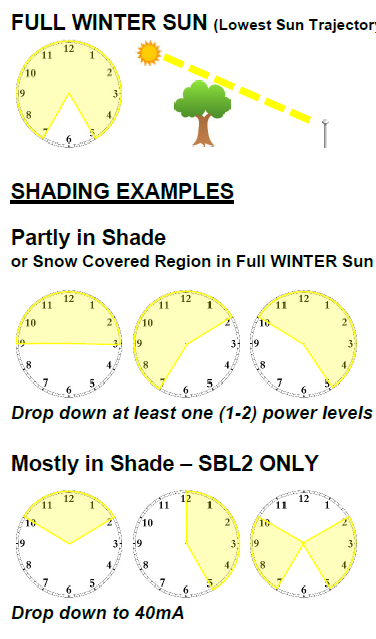
Solar bollard lighting shade assessment: upfront planning = successful and reliable solar lighting.

A successful and reliable solar lighting installation requires adhering to the ‘the power in = power out’ rule.
This enables Orca Solar Lighting® / Solar Bollard Lighting (SBL) to provide a 5-year (SBL) and 10-year (SBL2) warranty on performance is because every solar bollard light has a shade assessment to ensure the ‘power in – power out’ equation is adhered to. This is achieved by using different power model settings that allow for varying amounts of shade. Shade assessment is critical for any solar lighting installation.
To select the correct power model for the location, Orca Solar Lighting will work from Google Earth, Street View, photos and videos provided by the customer, or conduct a site visit to establish the amount of shade at each location. For most of Australia, this is based on the mid-winter sun scenario.
Mid-winter is the most testing time for solar lighting (in most locations in Australia), due to the longest winter nights, the shortest days, and the north low tracking sun when the shadows are the longest. Any shading from trees, buildings or fencing is accounted for. This enables a lighting plan with the appropriate power models to ensure reliable all night light and prolonged battery life by ensuring the battery receives adequate power in to recharge easily. Please note in tropical Northern parts of Australia, the summer monsoon months are the most testing time for solar lighting.
The sun is stronger the further you go North (in the southern hemisphere) and this coincides with the shorter winter night time lengths the closer to the equator you get. This has huge implications for solar lighting, therefore thorough shading assessments are essential to determine which power model will achieve the warranty-supported dusk to dawn 365 days a year performance. The power model is selected based on the sun’s path in the proposed installation position over the winter months.
The winter months are used because winter gives the worst case scenario: the highest amount of solar energy the bollard is able to capture with the shorter daylight hours (longest nights) – to ensure the power in – power out rule is adhered to. As mentioned above, the far North tropical parts of Australia have the most demanding solar months in their monsoonal summer season. This can demand more autonomy (battery back-up) – for more consecutive nights, however based off relatively short night time lengths compared to the longer winter night lengths in Southern regions.
As a general rule, the northern locations would suit a power model of solar bollard at or above 160mA (160mA is considered “standard”). Conversely, the southern locations of Australia would suit a power model of solar bollard at or below 160mA. The split between north and south with 160mA as the point of differentiation is a guide only, but a reasonable starting point when you are making decisions about solar bollard lighting for your project. Coastal regions tend to receive more cloud cover and rain, therefore this may affect the power model as well.
One very important consideration is the future shading from shrubs, bushes and trees in proximity to the solar bollard lights. It is surprising how quickly trees and shrubs can grow in a few years. In the southern hemisphere, looking for potential shade to the North of the solar light is the most important, as this is where the sun tracks low in winter.
For more information on the SBL solar lighting bollard range, please follow this link https://orcasolarlighting.com.au/solar_bollard_lighting
